NB This section being revised
There were several vehicles used for carrying road tank trailers, these started to appear I believe in the late 1920's and gained in popularity in the 1930's. Road rail tank wagons were used for, amongst other things, milk and beer traffic. Most of the road tanks were of the four wheeled trailer type although some of the earlier milk tanks and some post war beer tanks had six wheels. One common application was to carry 2,000 gallon road milk tank trailers as discussed in the section 'Freight Operations on British Railways' in the sub-section on Non Passenger Coaching Stock - Milk. The milk tank road trailers had a hand wheel at each end which I think was used to lock the suspension in transit to prevent the securing chains 'snatching' and possibly parting (I could be wrong on that, they may have been just a hand brake).
By the late 1930's a few articulated insulated tank trailers were in use (with the LMS and LNER), carried in pairs on six wheeled rail chassis. These were insulated and heated (via a dynamo on the six wheeled 19'wb 30'oh chassis) and were used for cargo such as seed and whale oils, which flow more easily when warm. I gather the LNER examples probably ended their days carrying milk but I have no definite information on this. In the post war era Guinness built a fleet of large 6 wheeled road tank trailers (discussed below) and the rail wagons used for these were again 6 wheelers.
The tank diameter was fairly consistent, 10mm is about right in N (handy as the biggest standard tube of Plastruct Fineline is about 9.5mm which is close enough). The wheels were generally about 5 feet apart, the wheelbase varied with the tank length and they had flangless metal wheels on the inside which ran onto rails mounted on the deck of the wagon in transit. To get the trailer onto the wagon a rope was attached to the tank and taken round a pulley at the far end of the wagon. This allowed the tractor to pull the tank onto the wagon (and in the 1930s it was often an agricultural type tractor, although fitted with a cab).
Beer tankers were carried on four or six wheeled chassis depending on the size of the tank. There was a fair bit of variation between individual wagons, so you have some leeway for modellers licence. The first milk road-tank wagons were built in 1931 by the SR and ran on 4 wheeled chassis (four wheeled milk tank wagons had appeared in 1927 and lasted until 1937). After 1931 all new chassis for milk tanks and milk road-tanks had six wheels, and they were fitted with continuous brakes as they were designed to run in passenger trains on the branch lines or at passenger speeds. All the wagons I have seen pictures of appear to be black with white markings, I believe the LMS and SR had plates on the wagon sides to carry the 'fast traffic stars' the LNER and GWR did not.
The deck fittings seem to have been pretty standardised for both milk and beer tankers. There were two 'rails' on the deck, tapering inwards at each end, on to which the trailers flangless inner wheels ran. There were two cross-bars, in the form of a shallow U, which attached to the rails just outside the flangeless trailer wheels, holding the trailer in place. There were some variations in the end ramps used to carry the trailer wheels over the buffers, the LMS and LNER had fold-over plates which lay flat on the deck. I think the SR also had lay-flat plates but I believe the GWR had plates which remained at an angle as shown in the sketch. Individual wagons may have differed however, work from a photo if accuracy is important.
The information is presented as a set of pictures, these will take a while to download, to save any one of these right click on the required picture and select 'save picture as'. The pictures can then easily be printed for reference.
Tank trailers used for beer and milk. These vehicles have metal disc wheels on the inside of the road wheels which run onto rails on the deck of the carrying wagon. It is not necessary to model these inner wheels in N. For the tank body use the largest Plastruct Fineline tube (TBFS12, 9.5mm diameter), wheels can be Dornaplas wheels on plastic rod or metal axles, or you can trim the flanges from Peco wagon wheels. For some of my road-rail tank trailers I have used Roco Minitanks wheels, I am not sure these are still produced but if so they are worth getting as you get a lot of wheels and steel axles in a packet, these are about the size of Peco wagon wheels with the flanges cut off but have nice detail moulded onto them. The mud guards came in in the 1940s I believe, these can be made using slices of the size of Plastruct TBFS10 tube which is a neat telescopic fit into the larger tube. One tip not mentioned in the drawings below would be to sand a flat on the bottom of the wheels to ensure a good joint with the body of the wagon. This is also handy if using a Peco bolster wagon body as it reduces the resulting height (the top of the dome on the tank should be the same height as the roof on adjacent vans). NB if using the (over scale) 12mm diameter Ratio oil tank for the body and cut down Peco wheels the wheels need to have 12mm axles on them, for the Plastruct tube the Peco spacing of about 7mm is near perfect. If using the Peco wheels these need to have the axle cut and extended by 4mm or so to suit the bigger tank. Peco, Dornaplas or Roco road wheels used with the Ratio tank need to be sanded down quite a lot on the bottom to reduce the height. 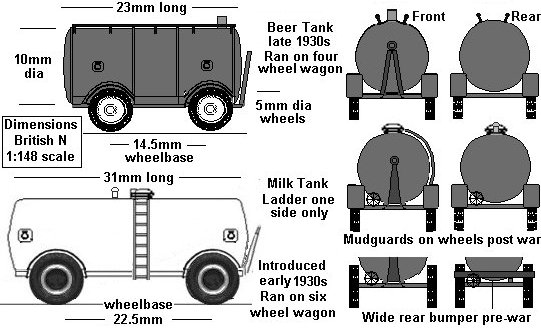 The beer tank appears to have had a dead-level tank body, I believe the milk tank was slightly higher at the front but in N a difference of 20 thou maximum should be considered. The road trailers on the wagons were the same height as a standard van, the standard milk tank wagons had quite a small tank diameter so the road tank was taller. The sketch below is based on a tracing of milk train, the angle of the photo exaggerates the difference in height slightly. 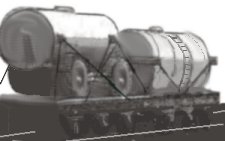 |
Generic details for road-rail tank wagons There were a number of road-rail tank wagons, in 1931 the SR introduced road-rail tanks for milk on four wheeled chassis, but later builds for all companies milk tanks were all on six wheel chassis. Four wheelers were the norm for beer tanks. For my beer tank wagons I used a Peco single bolster wagon with the top sanded down flat (until the plank lines had almost disappeared) so I could use the 'weight space' under the body to secure the ends of the 'chains' holding the tank in position. The body is then mounted on a standard Peco chassis. If using a 20 thou sheet deck, which is more prototypical, you need to remove the locating rings on the top of the chassis and sand it all smooth, then the couplings are fitted, coupling retainers can either be cut from the supplied pins or 4mm lengths of Peco sleeper can be used and the body glued down to the chassis. To secure the tank to the wagon you can run two cuts across the deck and insert Slaters 20 thou brass wires as shown in the photo, the ends are bent down and used to secure the inner chains, when the model is complete the brass wire is cut back and the ends pressed into the chassis sides. The end chains can then be taken to slots cut into the end of the Peco chassis just outboard of the buffers. This is the method I used for the milk tank wagon shown below. 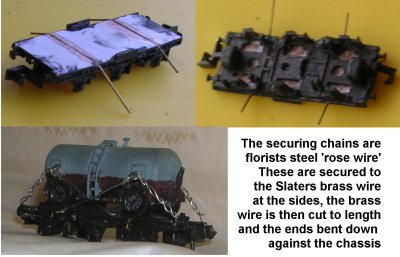 As can be seen from the photo the basic milk road tank six wheel wagons are not difficult to build, cut a wheel section from a Peco 10 foot steel chassis, remove the brake push rods and V hanger from a second chassis and cut a section from the centre of this, the size depends on the size of the wheel section, aim for a 13 foot wheelbase. The coupling are inserted and retaining pins, cut from those in the chassis kit or use 4mm lengths of Peco sleeper, are inserted and the three sections are glued to the 20 thou 'deck'. Finally add a tie-bar of Slaters 20 thou brass rod between the axle boxes. This leaves a shortage of brake gear but is much easier than cutting down the Peco fifteen foot wheelbase chassis as in that case the ends have to be shortened as well. A very simple to build LMS milk tank wagon is discussed below which uses the longer chassis. Generic body for road-rail tank wagons. This sketch shows the basic detail for a beer or milk tank trailer wagon deck. All but a couple of mine have been even more crude than the 'simple' version but I find them acceptable at 'normal viewing distance'. A loaded wagon with the tank trailer is in place is easy to model as much of the detail is lost to view and the simple option shown can be used. If you wish to be more detailed (the hole in the end of the rails is worth considering), or if you want an empty wagon, then you can opt for the more detailed approach as shown. 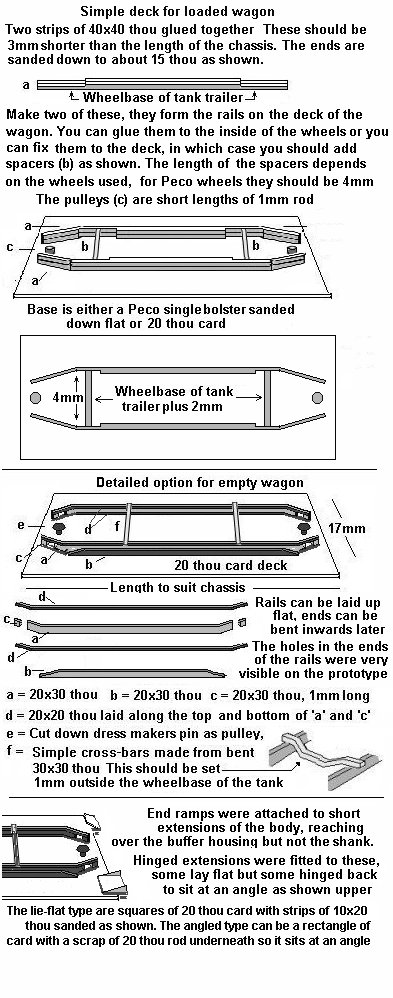 According to my note books the GWR milk tank wagons were slightly different in having a raised 'ramp' right across the end with a bay for the pulley wheel, however I am not sure this is correct as my reference books are all in storage at the moment. |
Crude model of a beer tank trailer The model shown here was made whilst traveling with what I happened to have with me at the time. It has been included here as it shows what black thread looks like as 'securing chain' and serves to show the height problem of the Ratio oil tank on a Peco body. The body of this very crude example is a 12mm diameter tube of some kind of flexible plastic which did not glue with anything other than superglue. I used 12mm as I mis remembered the tank dimensions, it is six foot over the side rings not the tank barrel. The ends are plastic card, about 30 thou, trimmed down and sanded to shape. The wheels are from a packet of 'Roco Minitanks' wheels and axles. The model was assembled as shown below although I was not able to attach the hand rail or the small cylinder to the body. The connecting hose wound round the tow bar is a scrap of (I think) 15 Amp fuse wire. The tank should be 'dull metal' with the mudguards and chassis light grey. The wagon is a Peco bolster wagon with the sides and ends trimmed down to floor level and the top sanded down. The 'chains' are black thread threaded through the body tube using a needle and superglued underneath the body in the space for the weight. I took then end strands through holes in the deck, it looks a lot better (and more prototypically accurate) if they are taken over the end as shown in the sketch below. To represent ring mounting plates on the tank side and the tension adjusters and sections of chain I added some additional thread wound round the securing thread near the hole then round the threads leading down to the body after the trailer was secured to the chassis. The 'lettering' on the wagon body was done with a shaved down tooth pick and white paint, I did not attempt to represent the lettering on the tank itself but small black dots would do. The guide rails on the deck of the body are just strips of 40x40 thou with the ends bent in. This is a bit low and if you use Peco wheels you will find you can manage about 60 thou in rail height, which would look better. Sanding the bent in ends of the rails down to about 15 thou as shown on the more detailed drawings improves the look of the thing. Using the Peco body makes the deck a bit high but gives space for the wagon number and two stars, I find this looks acceptable at a distance. 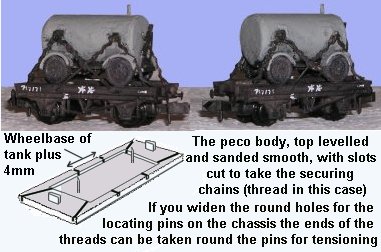 |
Modelling a Whitbreads beer tank trailer The model represents a Whitbreads road tank trailer on an LMS chassis to dia 2035 (lot 1419), two of which were built in 1946. My model is simplified in that I used a length of 40x40 thou strip for the small tank on the lower side, sanded to more of a curved shape after fitting. For the handrails on the top I used staples from a standard desk stapler, two Bambi stapes on each side would be finer in section and would look better I think but the ladder as suggested looks best. The model is painted in Humbrol 'matt bare metal' but this came out a bit shiny as can be seen in the photos, a good wash with dirty thinners dulls this down nicely. As the photo shows two such tanks in a parcels train I made two. 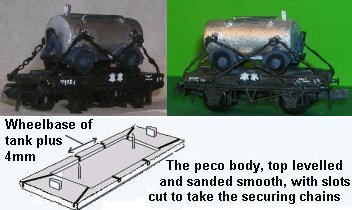 The wagon is simply a Peco single bolster sanded down flat and with the 'simple' version of the body detail as shown in the sketch below. Using a deck of 20 thou card with the brass wires run across as shown above would be preferable (this model was built for my own use, it was not intended to be seen in public). The securing chains are twisted up from single strands of brass wire taken from a length of picture hanging wire, this is stiffer but more brittle than 5 Amp fuse wire. The ends of the securing wires pass through slots in the sides and ends of the body and are superglued in the 'weight space' under the body. The slots in the sides are the tank wheelbase plus 4mm, those in the ends are as close to the sides as I could manage. Note when I fitted the tank I centred the wheels, so the tank is slightly off-centre, which is wrong, the tank itself should be centered (look down from above to check this). The paper 'cloth' cover on the filler has come adrift and been lost (I only noticed after taking the photo). 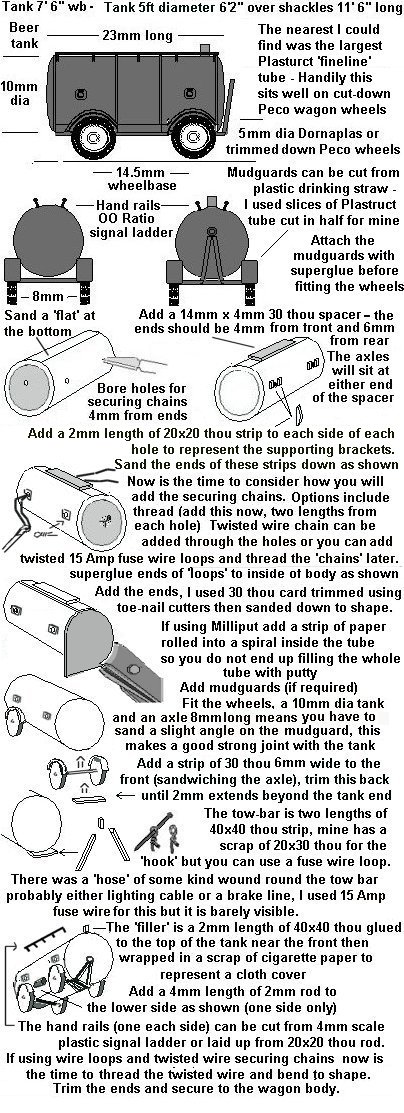 |
Livery notes for beer tank trailer The road rail tanks, being so few in number, were seldom photographed and tracing livery details has been extremely difficult. There were several companies operating this type of tank but during the BR era all but one of the new build wagons built were all for Guinness traffic. Guinness had a total of 23 six wheeler chassis built for their tank trailers, to dias 1/332 (16'wb 24'6" over headstocks built in 1951) and 1/335 (13'wb 20'6" over headstocks built in 1955). I believe the Whitbreads tanks (of which there were two) were in plain metal with black markings, these ran on LMS dia 2035 four wheeled 10' wheelbase chassis, one converted by the LMS the other converted by BR. I am told that Bass operated some road-rail tanks (about which I am unsure, there are non listed in Don Rowlands book on BR goods wagons but as they were piped for steam heating they may have ended up in the non passenger coaching stock lists). Graeme Wall (a regular on the uk.railway newsgroup) was able to advise that: The Great Western Society has a road/rail tank which is ex Courage brewery in Reading. They describe it as a 'ROTANK'. It was reused as a milk tank at some point, but as you can see from the photo, the original Courage red livery is showing through the white. 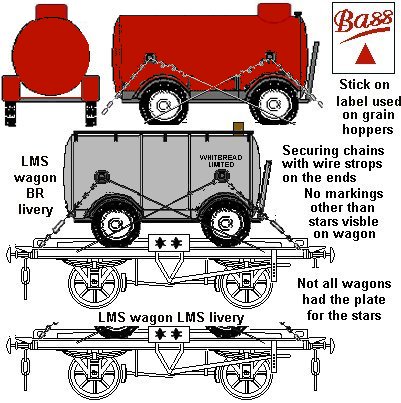 There is a photo in Janet Russel's book on GWR Company Servants showing a BR era road tank trailer being unloaded, the details of the wagon cannot be seen but the tank appears to be in plain (maroon?) livery (it is a black and white photo). This looks like one of the Guinness tanks with the large filler dome cover but does not have the Guinness livery and looks to be in a lighter colour. I made a model of this tank as shown above but with the more modern filling dome made using some 3mm diameter tube, capped with 40 thou card and sanded to shape. If capping the tube rather than filling it with putty you should drill a hole in the tank body under this to avoid glue vapour getting trapped in the space inside the 'dome'. The grating walkway on my model is cut from the top of a Peco 10 foot wheelbase tank, the ladder is also from a 10 foot wheelbase tank kit, this has to be trimmed at each end to suit, I made a small hole with a modelling knife to take the mounting pin on the ladder. This ladder is way over scale, I should have used brass signal ladder, but the model was made more as an experiment than as a practical vehicle, it turned out not too bad and eventually got a proper repaint and a wagon to carry it. The sketch shows two methods for making the large tank top domes used on tanks since the later 1950s. 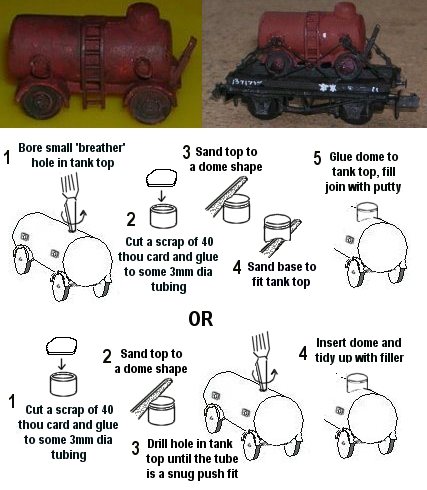 |
Modelling a milk tank trailer My own rather crude model, shown here having been repainted before and after mounting on a new wagon, is in a post-war livery. I believe that during the war all the tanks were painted an all-over grey, the brown lower sides and mudguards were, I think, a post war variation. Some later LMS milk tank trailers had a walkway along the length of the tank, off-set toward the ladder side, this would be difficult to model and I did not fit one. When the photos were taken I had not yet fitted the tie-bars between the axle boxes on the wagon chassis, for this I use Slaters 20 thou brass rod secured with Superglue.  This model uses the Ratio oil tank, lengthened using a section cut from a second tank, and Roco Minitanks wheels (worth getting if they are still available). The side rings are 15 amp fuse wire, florists steel 'rose wire' is a better option, twisting the wire round the end of one side of fine long nose pliers gives you a prototypical D shaped ring. The rectangles around the securing lugs were cut from Plastruct square section tube, I should have sanded these down more before fitting the securing loops, on the model they extend about 1mm from the sides. The filler cap is a section of round section sprue, the vent is a dress making pin cut to length so when in place the base is on the bottom of the tank. The ladder (one side only) is from a Peco 15' wheelbase tank, this proved very brittle and in fact it is glued on in sections, with a small scrap of 40x40 thou supporting the lower part where the tank body curves inwards. When originally built this tank ran on a long wheelbase wagon based on the Peco plate wagon with extra wheels but as the Ratio tank is over size it was about 2mm higher than the other stock. I therefore built a new wagon with a 'body' of 20 thou card and I also sanded quite a lot from the bottom of the wheels. The sketch assumes you will be using the (more accurate) Plastruct tube for the tank body, in which case you can use a higher body. The securing chains on this model are florists steel 'rose wire', twisted to represent the chain and tensioners for the end sections, straight for the central strops. In practice I think the black thread approach used on the crude beer tanker above looks just as good in practice. 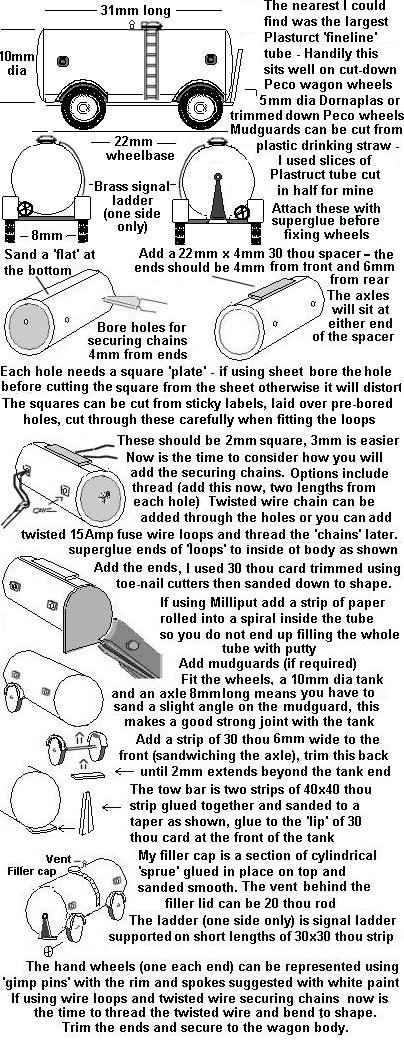 |
Example milk tank liveries. NB These liveries are distinctly 'iffy' - If you have or can find a photo use that! The tank liveries shown are all taken from my notebooks but only the CWS livery is confirmed as accurate (and I am unsure as the tank base colour). They were obtained from black and white photographs, the two-tone brown and grey was commented somewhere and I made a note of it, apparently there was a number in white at one end of the tank, about six inches high, which showed up clearly, I did not record the number. |The silver and blue livery is from a memory of a road tanker and follows the standard livery for milk tanks from the later 1960s on. The official post war livery for MMB tanks was light blue then silver (which faded to white) but all milk tanks in the post war era were filthy judging from photographs. Note I believe the front end of the tanks was slightly higher than the rear, the difference was not great and in N a difference of 20 thou maximum should be considered. 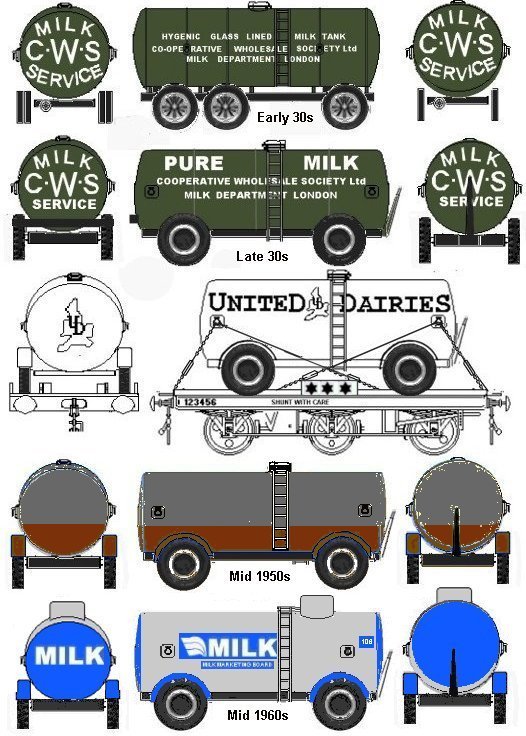 The tank transporting wagons were all black with white markings, milk tank trailer wagons qualified for a three star rating, some companies (LMS and SR) had the stars on a plate sticking up above the side, I believe the GWR and LNER had smaller stars painted on the chassis (I could be wrong on that). |
Quick and simple LMS milk or BR beer tank wagon. The Roche drawings include what is described as 'modern carriage truck' (G/114), this has a 16 foot wheelbase and a body about 25 feet long. Most milk road-rail tanks were moved on a six wheeled chassis but a twelve or thirteen foot wheelbase and rather shorter ends was the norm. I was unsure on this model as I do not currently have access to my original notes or the Roche drawing so I asked on the uk.rec.models.rail newsgroup where Mr Alistair Wright of the LMS Society was able to advise that - To me the drawing looks very similar to Diag 1990 in LMS Coaches Vol 1 pages 130 (foot) and 131. The capacity of this is also correct at 15 Tons as per R.J. Roche. This model formed one of my early attempts at rather basic kit bashing, although the initial attempt at a road-rail tank load was awful and the later try using Ratio tank parts (similar to the milk tank shown above) stood too tall the wagon itself was easy enough to make and does look visibly different from the norm. The notes below are based on my own model and may not be accurate, I do not currently have access to either the R. J. Roche drawing or the book mentioned by Mr. Wright. This drawing should therefore be considered provisional, a more accurate drawing may appear once I regain access to my books (unlikely before 2008). In spite of its length I believe this wagon carried a single tank as my sketch shows only four mounting points for the cross-bars which acted as chocks for the inner steel disc wheels. 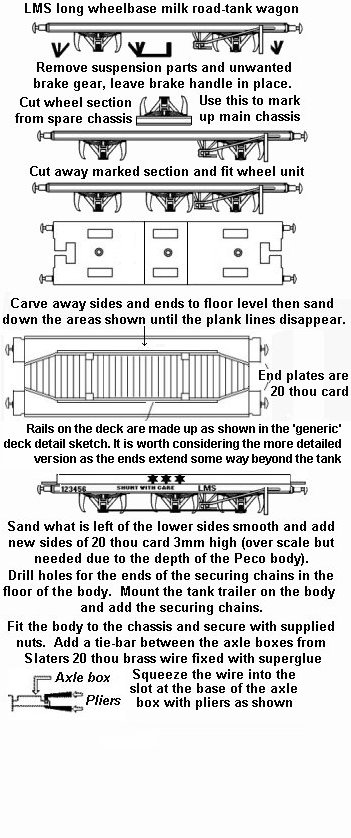 |
| Guinness tanker for the 6 wheeled chassis The Roche drawing may have shown the 1951 BR built dia 1/332 - There were a fleet of 18 6 wheel chassis for Guinness road rail tanks, later an additional 13 wagons were provided (to a different diagram) providing a fleet of 31 wagons by 1955. The tanks were of conventional design, but differed in detail between batches and later versions had two filling domes toward the front end, these tanks ran on six road wheels rather than the more usual four. Guinness favoured larger 6 wheeled wagons to carry them, earlier beer tanks were on four wheeled chassis. They were secured using rings on the tank sides as for the smaller tanks. There was a ladder on one side of the tank (possibly on both but I do not think so). 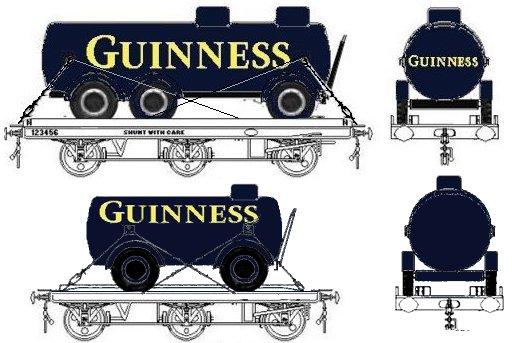 Langley offer a similar tank in OO, their model has no tank side securing points, it features a one-piece mudguard over the rear wheels and has a platform around the filling domes with an end mounted ladder. The catalogue shows the tank sitting higher on the wheels than my sketch and in a light body colour with dark lettering but I am pretty sure that the lettering should be as per my sketch. The Langley model may well represent a slightly different design from the tank shown in my sketch, however my drawings are based on photographs and hence are correct as regards general details. The Guinness deliveries from their Park Royal brewery in London to the various 'stores' depots around the country were truly epic in nature. Up to World War Two the stout was shipped in wooden casks, local deliveries (including the south Midlands and East Anglia) were by road, further afield Guinness stores were supplied by rail. During and after the war the shortage of American oak for the casks lead to a move toward bulk shipments, 500 gallon stainless steel demountable tanks proved a success (over a thousand were built) and road tank trailers were supplied in some numbers as well as a fleet of eight wheeled tanker lorries (operated up to 1953 by the firm of Thomass Allen, who had been road-hauling Guinness for many years). Following the nationalisation of road haulage British Road Services had to be employed for deliveries of more than 25 miles from base but in 1953 the fleet of Thomass Allen delivery vehicles (and most of the staff) were purchased by Guinness and reestablished as Park Royal Transport Ltd). On the railway side there was a twice weekly block train up to the distribution and bottling plant in Newcastle with open wagons filled with casks and several demountable tanks as well. The road rail tanks were used to supply depots in Newcastle, South Wales and Plymouth (as well as other destinations). |
| Ratio Oil Tank Kit Parts The kit comprises parts for two tanks, each tank has a smooth lower half (A), an upper half with two filler caps (B), one end with a small 'valve' (C) and one with a larger port (D). Other useful bits are the small hand wheels (E) and the blanking plates with a ring of bolts mounted on them (F). Of possible use are the 'brick' tank supports (G), which can be cut down to represent cradles in some applications. There is also some 'pipework' which can be cut about for details. 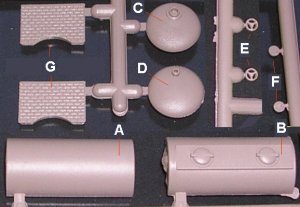 The central tube is 25mm long, the Ratio ends add about 1.5mm to each end, so the overall length is close to 28mm. The diameter is about 12mm. This is about 2mm too large for the diameter, over long for a beer tank and a bit short for a milk tank trailers. You can make one of each type, using a section cut from one to extend the other, but you can get away with the standard Ratio offering. The main problem with the tank diameter is the overall height of the model, tanks made from Ratio kits need to be on a deck of 20 thou card, not a sanded down single bolster, which makes adding the chains a tad more awkward as you have to add the brass wires across the body and cut slots into the ends of the chassis. Also Peco wagon wheels cannot be used as-is, the axle has to be cut off and replaced by a wire rod as the Peco wheels are too close together for a tank of this size. Dornaplas wheels can be used mounted on a plastic rod, the wheels need to be about 12 mm apart. To use the tank ends in many cases you will need to trim away the moulded ports, however this can be done (with care) with a scalpel. |